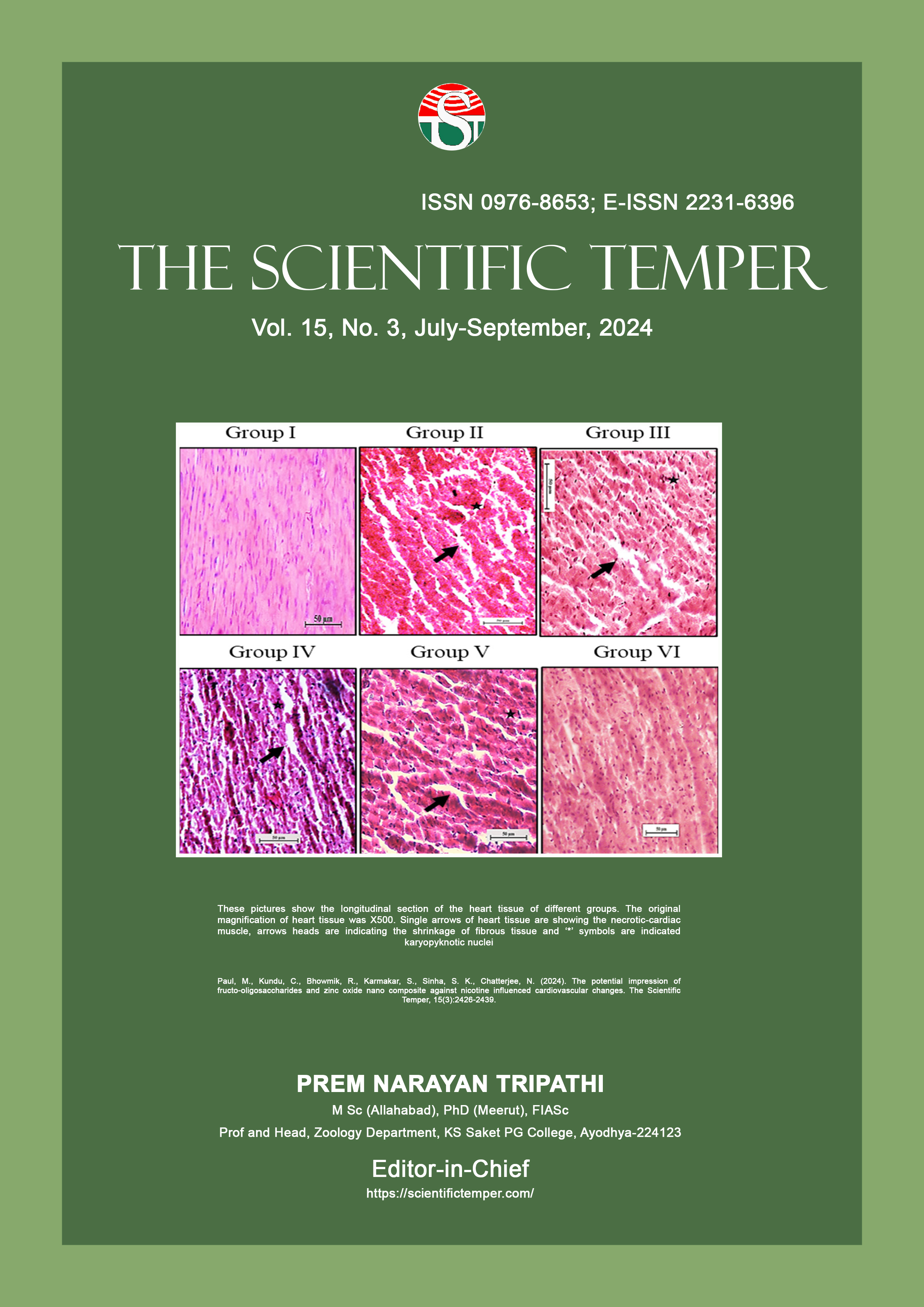Piecewise adaptive weighted smoothing-based multivariate rosenthal correlative target projection for lung and uterus cancer prediction with big data
Downloads
Published
DOI:
https://doi.org/10.58414/SCIENTIFICTEMPER.2024.15.3.65Keywords:
Lung and uterus cancer detection, big data, preprocessing, Piecewise Adaptive Constant Interpolation method, Gower's weighted smoothing technique, Peirce's statistical test, feature selection, Multivariate Rosenthal correlative target feature projection techniqueDimensions Badge
Issue
Section
License
Copyright (c) 2024 The Scientific Temper

This work is licensed under a Creative Commons Attribution-NonCommercial-ShareAlike 4.0 International License.
Cancer is the uncontrolled growth and spread of abnormal cells in the body. Early detection and prediction of cancer are crucial aspects of modern healthcare aimed at greatly improving the chances of survival for patients by reducing mortality rates and the number of people affected by this disease. Due to the large volume of data generated in the medical industry, accurate cancer detection is a challenging task. Many cancer classification systems using machine learning and deep learning models have been developed but accurate cancer detection with minimal time consumption remains a major challenging issue in the big data applications. To enhance the accuracy of cancer detection with minimal time, the Piecewise Adaptive Weighted Smoothing-based Multivariate Rosenthal Correlative Target Projection (PAWS-MRCTP) technique is introduced. This technique aims to detect lung and uterus cancers while leveraging big data. The proposed PAWS-MRCTP technique comprises three main processes namely data acquisition, preprocessing, and feature selection. In the data acquisition phase, a large number of cancer patient data are collected from lung cancer and uterus cancer detection datasets. Subsequently, the collected patient data undergo preprocessing. The preprocessing stage comprises three key processes namely handling missing data, noisy data, and outlier data. Firstly, the proposed PAWS-MRCTP is employed to address missing values, utilizing the Piecewise Adaptive Constant Interpolation method based on multiple available data points. Noisy data are identified using Gower's weighted smoothing technique, which detects data containing random variations or errors. Subsequently, outlier data are identified and removed by applying Peirce's statistical test. As a result, the pre-processed dataset is obtained resulting to minimize the time complexity. With the pre-processed dataset, the feature selection process is carried out to minimize the dimensionality of the large dataset. The proposed PAWS-MRCTP technique utilizes the Multivariate Rosenthal correlative target feature projection technique to identify the most relevant features. By selecting significant features, this approach enhances the accuracy of lung cancer and uterus cancer detection with minimal time consumption. Experimental assessment is conducted with different evaluation metrics such as cancer detection accuracy, precision, and cancer detection time and space complexity. The observed result shows the effectiveness of the proposed PAWS-MRCTP technique with higher accuracy with minimum time than the existing methods.Abstract
How to Cite
Downloads
Similar Articles
- V Babydeepa, K. Sindhu, A hybrid feature selection and generative adversarial network for lung and uterus cancer prediction with big data , The Scientific Temper: Vol. 15 No. 03 (2024): The Scientific Temper
- P S Renjeni, B Senthilkumaran, Ramalingam Sugumar, L. Jaya Singh Dhas, Gaussian kernelized transformer learning model for brain tumor risk factor identification and disease diagnosis , The Scientific Temper: Vol. 16 No. 02 (2025): The Scientific Temper
- V. Umadevi, S. Ranganathan, IoT based energy aware local approximated MapReduce fuzzy clustering for smart healthcare data transmission , The Scientific Temper: Vol. 15 No. 03 (2024): The Scientific Temper
- Madhuri Prashant Pant, Jayshri Appaso Patil, Unlocking the potential of big data and analytics significance, applications in diverse domains and implementation of Apache Hadoop map/reduce for citation histogram , The Scientific Temper: Vol. 16 No. Spl-2 (2025): The Scientific Temper
- P. Vinnarasi, K. Menaka, Advanced hybrid feature selection techniques for analyzing the relationship between 25-OHD and TSH , The Scientific Temper: Vol. 16 No. 02 (2025): The Scientific Temper
- Thangatharani T, M. Subalakshmi, Development of an adaptive machine learning framework for real-time anomaly detection in cybersecurity , The Scientific Temper: Vol. 16 No. 08 (2025): The Scientific Temper
- Anita M, Shakila S, Stochastic kernelized discriminant extreme learning machine classifier for big data predictive analytics , The Scientific Temper: Vol. 15 No. spl-1 (2024): The Scientific Temper
- R Prabhu, S Sathya, P Umaeswari, K Saranya, Lung cancer disease identification using hybrid models , The Scientific Temper: Vol. 14 No. 03 (2023): The Scientific Temper
- Raja Selvaraj, Manikandasaran S. Sundari, EAM: Enhanced authentication method to ensure the authenticity and integrity of the data in VM migration to the cloud environment , The Scientific Temper: Vol. 14 No. 01 (2023): The Scientific Temper
- Jayalakshmi K., M. Prabakaran, The role of big data in transforming human resource analytics: A literature review , The Scientific Temper: Vol. 15 No. spl-1 (2024): The Scientific Temper
You may also start an advanced similarity search for this article.
Most read articles by the same author(s)
- V Babydeepa, K. Sindhu, A hybrid feature selection and generative adversarial network for lung and uterus cancer prediction with big data , The Scientific Temper: Vol. 15 No. 03 (2024): The Scientific Temper



